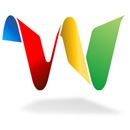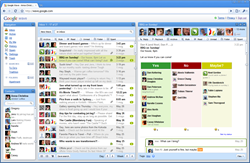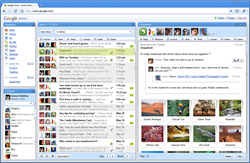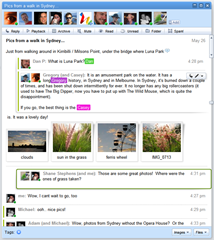 Google Wave could transform how we communicate over the web, instead of email, we may all use Google Wave, after all it is being described as what email would be like if it was invented today.
Google Wave could transform how we communicate over the web, instead of email, we may all use Google Wave, after all it is being described as what email would be like if it was invented today.
The video is embedded below in which Lars and Jens Rasmussen and Stephanie Hannon presented the demonstration of Google Wave at Google’s developer conference, Google i/o. Google Wave compared to the web of today, provides some ‘wow’ moments without Flash, the video shows this better than I can explain it so is worth a watch. If you haven’t got an hour and twenty minutes to spare on the video, I have provided a quick write-up of the features presented.
Wave can be viewed from a browser such as Firefox, on a mobile or from a dedicated Wave client. Full functionality will be available from the Wave client and probably the web browser. Functionality may be limited on the mobile web browsers.
Messaging and Interaction
Messages are threaded, much like Gmail. Unlike Gmail it appears cleaner but this may just be during development when info such as headers are kept hidden.
Multiple contacts can be involved in a ‘Wave’. A wave can be a stream of messages, emails, photos , much like an inbox with conversations going on.
If contacts have their Wave client open or are viewing it in their browser, they will be able to see the characters appear on screen as they are typed, instead of waiting and watching the typical "Jimbo is typing a message…" notification until the entire text appears. There is a tickbox so you can prevent this from happening for the message you are working on, so the entire message appears at once in the classic fashion once you click OK.
When creating messages, there is a live spellchecker, no longer do you have to complete a message and activate the spell check as it actively works as you type, something I could do with when writing these blog posts!
When a user replies to the wave, they can reply to a message within the stream of messages. Imagine current email, you may have a conversation 10 emails long, rather than replying to the last one with the message appearing as a new email to everything that has been discussed so far, you can go to a message part way along the chain and reply directly to that, and this will be reflected with the message appearing directly below the item that was replied to.
If you wish to add someone to the Wave that you are participating in, you can just drag their name/icon from the contacts list, into the bar at the top of the current wave where the participants are shown. The new user will then have a copy of the thread/wave of messages as you see it so far. Because of the threaded nature of display, the new user, without looking at all the timestamps, cannot easily work out which message was replied to in which order, so the flow of conversation may not be clear. The solution to this is a handy playback feature which re-plays the conversation, displaying items in the order they were sent.
Now, the problem with a Wave of multiple participants, is that you may want to send a message to an individual that you may not want others to see, for which there is a Private Reply option, so only the person you are replying to can see the message. This ensures that all relevant information pertaining to a wave is kept within the wave rather than starting a new email/messaging conversation. Other users can be added to the private reply so it isn’t just limited to the sender of the message you are replying to.
Photos
Adding photos according to the demonstration couldn’t be easier, just drag them from the desktop/file manager, directly into the browser and a new message is generated ready for you to add your own text or more images. In the same vein as the real-time instant messaging, the thumbnails of hte images are displayed before the complete image has been uploaded so that other users viewing the wave can see them. According to the demonstration the drag and drop feature isn’t part of HTML 5 and they want to get it added and standardised and so Google Gears will be required until then for this feature to work.
The photos in the wave can also be turned into a group photo slideshow with minimal effort. Items such as the photos or messages from a wave can also be placed into a new wave or message/message stream where new participants can see what you want to show them and this thread can be kept separate as with a new email conversation.
As with live editing, any edits made to the photos such as captions will appear in real-time in the Wave clients of those who are participating in the wave. This also applies in the scenario when a Wave is embedded elsewhere such as on a website…as below.
API
Using the Waves API allows waves to be placed onto a website, simply adding a blog or site as a participant will allow you to do this once the additions on the website have been done. Another interesting thing is that the wave feature of replying is also available from the website where the wave is embedded. These messages from the web embedded wave appear live within the Wave Client and vice versa. When participating from the web, the user can also continue their participation from their own Wave Client also with the follow up replies also appearing on the web and anywhere else the Wave is embedded. This means that once a comment is left on a site, you won’t have to go back or rely on email notifications to see if there were replies relevant to you, as you will have the stream of messages appear in your Wave client as a new wave.
Collaboration
With Wave’s connectivity and live update functionality, it makes it ideal for live content collaboration tasks. In the example shown a message was sent (wave was started) with multiple participants. An edit was made by one of the participants. This edit showed up in the clients of the other members of the wave as highlighted text along with the name of the person making the edit. The playback option allows edits to be seen in the order they were made along with messages left inline within the document. Messages can also be placed mid document/message by other wave members as a way of commenting/discussing content. Something that could change the way wikis like Wikipedia work with edits, version control and discussion of edits, live on the web, all of which can be hidden to reveal the final document for the public.
With live editing, multiple members of a wave can edit the same document at the same time and this will be shown on the screen with a highlighted block of text as it is being edited, with different coloured blocks representing different users. The demo showed five blocks in different colours darting about the page making edits and creating new text.
Organising Waves
Relevant content and messages may be contained within a single wave but eventually, like email there will be multiple conversations and messages and in this case, waves. The way Waves allows organisation is by utilising tags and these can be seen by everyone in the wave. Also like an interactive and live contents/index page, a wave can be used to link to other waves that may be relevant to the topic. So rather than having information scattered around your inbox across multiple conversations, waves lets you place links to other conversations/waves in a single ‘index or contents page wave’, saving you from searching for various terms.
In the Wave client that was shown, a search can be carried out and instantly, waves with messages containing matching strings will be displayed below as results, without having to press enter or confirm a search. This is nothing new, but with the live and instant functionality of Waves, when another person creates a message/starts a wave containing the text you are searching for and includes you as the recipient/participant in that message, it will appear instantly in your search results.
The message from other participants in the wave with the matching text doesn’t even have to be sent, as soon as the search string is found during composition, it appears in the search results of any participant running a search. If a letter is deleted from the string so it no longer matches, the wave disappears from search results immediately.
Extensions/Gadgets
Like with add-ons for Firefox, additional functionality and what would seem like intelligence, can be added to Waves. The examples included the spellchecker, mentioned previously, that would not just check spelling based on a dictionary of words, but apparently, using its knowledge of context and how the words are used in sentences on the Web, can work out what word should be used when the writer makes an error with words that have homophones, such as ‘to,’ ‘too’ and ‘two’. In the demo, the sentence "Icland is an icland" is typed with the spellchecker correcting automatically to output "Iceland is an island."
Apparently, robots (software ones!) watch the waves and messages from the server in order to carry out actions like the spell check or the live conversion of a plain text string such as "google.com" to a hyperlink and then unlinking it when it is changed to "google.com.a" and then re-linking it when it finally ends up being "google.com.au".
Another extension shown was search related. By clicking an icon in the text formatting toolbar for a wave, a drop down box appeared where the user can type a query to make live results appear and each result has a link "Add to wave," which when clicked adds the link to the current active wave. The same applies for images and presumably video or shopping results from the search extension.
There were other examples of incorporating collaboration with extensions/gadgets such as a Yes, No or Maybe gadget for a trip to the cinema where users would click Yes, No or Maybe and their name and icon would appear under the appropriate column. Gadgets can allow for integration between other communication services such as the ever popular Twitter, allowing tweets to be posted and searched from Google Wave. There was also a demo of a chess game and collaborative Sudoku game with real time updates and scoring.
Open Source
Google Wave will be open source, allowing other to start up competing wave providers with their own branding but users on different systems will be able to communicate with each other in the same way people can email each other even though they are using different providers. Private replies within users on the same provider’s service stay within that providers systems and will not cross over to the systems of another provider, unlike a message open to the participants from another wave provider. Allowing other organisations to take up Wave and provide their own service might encourage the transition from email. Factors such as service reliability, appearance, customisation options, addition of custom server-powered gadgets/extensions may affect which provider people choose.
When available it should be up at wave.google.com later in the year according to Lars but for now there is a link to the video embedded above along with further links about the protocol, and information for developers.
Google Wave Home
Wave Protocol
About Google Wave
Sign Up For Google Wave
Google Blog Post

